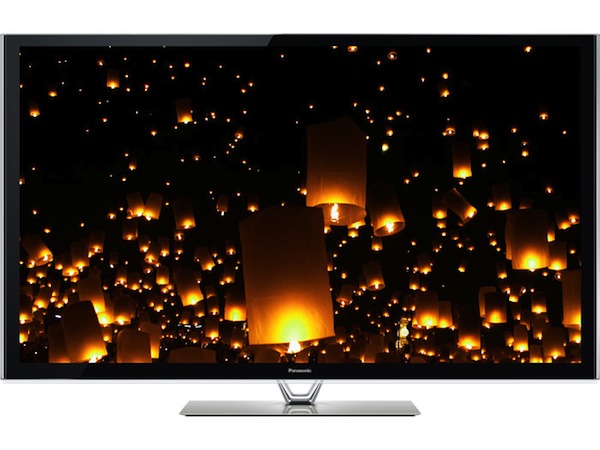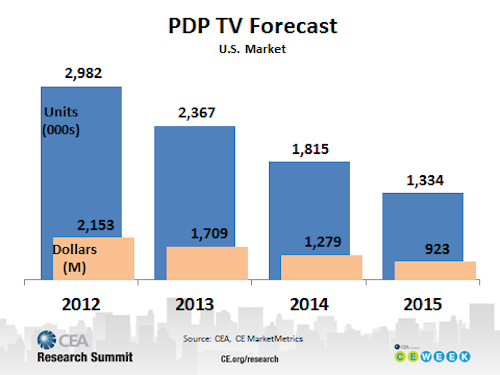Why Plasma TVs Are Dying
Standard-bearer Panasonic's rumored exit from the plasma-TV business shows that quality and a good price aren't enough to sell a TV.

Panasonic, the biggest champion of plasma TVs, is giving up the ghost and will be closing its last plasma factory in 2014, Reuters has reported. (In response to an email from Tom's Guide, Panasonic said, "The content of the report released overnight is not something that was announced by Panasonic.")
Regardless of whether Panasonic is closing up its plasma shop, the technology is on a fast decline. "Plasma has some life left, but by 2015, the market opportunity is getting small," Steve Koenig, director of industry analysis at the Consumer Electronics Association, told Tom's Guide.
MORE: 5 Easy Tips for Buying an HDTV
The numbers Koenig provided make that very clear. In 2012, U.S. consumers spent $2.15 billion on 2.98 million plasma TVs; by 2015, they are expected to buy just 1.33 million sets for a total of $923 million. That's still a lot of money, but not necessarily the best place for a TV maker to invest. In comparison, Americans spent about $16.8 billion on about 36.2 million LCD TVs in 2012. Those figures are expected to increase slightly by 2015.

But the business numbers only say so much. It's people's taste in TV that drives these numbers, and that taste isn't motivated entirely by quality, or even price.
"It would be sad to see such fine displays end production," said Joel Silver, founder of the Imaging Science Foundation, about Panasonic plasma TVs. Silver trains TV calibrators and consults with manufactures to improve the image quality and usability of their TVs. And his choice model for training sessions is a plasma TV from Panasonic's ZT line.
The old wisdom goes, and it's still somewhat true, that plasma beats LCD in some quality respects — particularly wider viewing angles and the ability to show motion clearly, which is a plus for sports fans. Plasmas also excel at showing deep blacks, which equates to better contrast and more-detailed images. Plasma TV had also been known for better colors. The LED-backlit LCD TVs that dominate the market have closed the color gap, Silver said. But plasma was in trouble long before LCD was competitive from a quality standpoint.
It's no secret that the best quality doesn't always win — that's been the case from Betamax vs. VHS to CD vs. MP3 to Blu-ray vs. Netflix streaming. More surprising is that even better prices didn't motivate people to buy plasma.
MORE: 2013 Best LED TV Reviews and Comparisons
For any size TV you want, plasma will provide a better deal. Say you are looking for a 55-inch TV with the works: 3D, Internet connection, top image-quality tech. Amazon sells one of Panasonic's best LCDs, the WT60, for $2,889.99. Amazon also sells Panasonic's ST60 plasma TV, which got a 5-star rating and Editors' Choice from CNET, for $1,295.00. (The LCD comes with an extra pair of 3D glasses, but that hardly accounts for the difference.)
The comparisons are similar at LG and Samsung, the two other companies that still make plasma TVs.

For some reason, LCD is perceived as better. Perhaps it's because the screens tend to be brighter (though plasma is far from dim) or perhaps because they may use a bit less electricity (even though plasmas are on a par with just a few incandescent light bulbs in terms of power use). Maybe it's because LCD is perceived as newer (at least it was in the last decade.) Plasma also got a bad name because of early models that "burned in" images that were left on the screen too long, thought that's not really a problem anymore, either.
It seems that no matter what, people are not swayed to go for plasma — not on quality, not on features, not even on price. If that's the case, how could plasma possibly survive?
Follow Sean Captain @seancaptain and on Google+. Follow us @tomsguide, on Facebook and on Google+.
Sign up to get the BEST of Tom's Guide direct to your inbox.
Get instant access to breaking news, the hottest reviews, great deals and helpful tips.
Sean Captain is a freelance technology and science writer, editor and photographer. At Tom's Guide, he has reviewed cameras, including most of Sony's Alpha A6000-series mirrorless cameras, as well as other photography-related content. He has also written for Fast Company, The New York Times, The Wall Street Journal, and Wired.
-
patrick47018 Because they only come in huge size, use a lot more power, and to me I prefer my LED IPS LCD.Reply -
ubercake Even though they've made improvements in the area with plasma screens, burn-in has always been the major deterrent. Why worry when you don't have to? As LCD/LEDs have come down in price and provide great pictures even compared to plasma while using far less power, people are passing on plasma altogether.Reply -
jtd871 Smallest sized plasma that I can find is 42-inches. My cabinet only fits a 39 or 40 incher. I would buy a plasma in the size I want.Reply -
XxXGunXxXGraveXxX I am reading this article on a Panasonic s60 50 inch and it is crazy to think anyone would buy a lcd or led over this tv. I paid 650$ and everyone who comes over always asks what kind of tv mine is because the picture is so crystal clear. My best friend has a 60 inch led or lcd i cant recall which and he paid 2 grand for it and he even said he wished he would have bought the 60 inch version of my s60 pasma instead! Its just no one reaseaches tv's before they buy them and as a result uy the biggest piece of shi* walmart has thinking that has to be the best on the market....Thanks mindless drones for ruining the best quality displays on the market aside from oled's that cost 10 grand.....Reply -
outlw6669 I have since a few years a 50" Plasma and I much prefer it over any LCD model my friends have.Reply
Deep blacks, great color and motion that smash what I see in comparison from the LCD camp; at less than half the price of any comparable LCD TV at the time.
Aside from the somewhat higher power consumption, the only drawback I have found is the reflective screen.
Quite disappointed to see another (mostly) superior, not to mention lower priced, tech being killed off :( -
_Cosmin_ Well i own a Panasonic Viera (smart plasma) TV: it is the BEST... and it come with 5 yr warranty (most LED/LCD come with 2 yr only)!Reply -
Heironious I bought a 42" LED LCD 3D tv because it was on sale boxing day for 450 dollars...FOUR HUNDRED AND FIFTY DOLLARS!!!!!Reply -
kawininjazx I really love my panasonic plasma, the picture is great. It does eat up a lot more electricity than an LED, but I don't have issue with ghosting. If I watch a 3 hour movie with black bars and then I exit and go into the PS3 main XMB, there is a slight ghosting for about 30 seconds, that's as bad as it gets. I don't like the 120 or 240hz LCDs at all.Reply -
nikoli707 the reasons for the popularity lcd is simply and purely.... lack of education. plasmas are vastly better than lcd's.Reply
